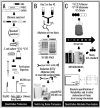Omics markers of the red cell storage lesion and metabolic linkage
- PMID: 28263171
- PMCID: PMC5336335
- DOI: 10.2450/2017.0341-16
Omics markers of the red cell storage lesion and metabolic linkage
Abstract
The introduction of omics technologies in the field of Transfusion Medicine has significantly advanced our understanding of the red cell storage lesion. While the clinical relevance of such a lesion is still a matter of debate, quantitative and redox proteomics approaches, as well quantitative metabolic flux analysis and metabolic tracing experiments promise to revolutionise our understanding of the role of blood processing strategies, inform the design and testing of novel additives or technologies (such as pathogen reduction), and evaluate the clinical relevance of donor and recipient biological variability with respect to red cell storability and transfusion outcomes. By reviewing existing literature in this rapidly expanding research endeavour, we highlight for the first time a correlation between metabolic markers of the red cell storage age and protein markers of haemolysis. Finally, we introduce the concept of metabolic linkage, i.e. the appreciation of a network of highly correlated small molecule metabolites which results from biochemical constraints of erythrocyte metabolic enzyme activities. For the foreseeable future, red cell studies will advance Transfusion Medicine and haematology by addressing the alteration of metabolic linkage phenotypes in response to stimuli, including, but not limited to, storage additives, enzymopathies (e.g. glucose 6-phosphate dehydrogenase deficiency), hypoxia, sepsis or haemorrhage.
Conflict of interest statement
Though unrelated to the contents of the manuscript, the Authors disclose that ADA, TN and KCH are part of Endura LLC. ADA is a consultant for New Health Sciences Inc. The other Authors declare no conflicts of interest.
Figures




Similar articles
-
Hitchhiker's guide to the red cell storage galaxy: Omics technologies and the quality issue.Transfus Apher Sci. 2017 Apr;56(2):248-253. doi: 10.1016/j.transci.2017.03.006. Epub 2017 Mar 9. Transfus Apher Sci. 2017. PMID: 28343934 Review.
-
Metabolomics of ADSOL (AS-1) red blood cell storage.Transfus Med Rev. 2014 Apr;28(2):41-55. doi: 10.1016/j.tmrv.2014.01.003. Epub 2014 Feb 5. Transfus Med Rev. 2014. PMID: 24636780 Free PMC article.
-
From omics technologies to personalized transfusion medicine.Expert Rev Proteomics. 2019 Mar;16(3):215-225. doi: 10.1080/14789450.2019.1571917. Epub 2019 Jan 28. Expert Rev Proteomics. 2019. PMID: 30654673 Review.
-
Purinergic control of red blood cell metabolism: novel strategies to improve red cell storage quality.Blood Transfus. 2017 Oct;15(6):535-542. doi: 10.2450/2017.0366-16. Epub 2017 Apr 12. Blood Transfus. 2017. PMID: 28488967 Free PMC article. Review.
-
Metabolic pathways that correlate with post-transfusion circulation of stored murine red blood cells.Haematologica. 2016 May;101(5):578-86. doi: 10.3324/haematol.2015.139139. Epub 2016 Feb 26. Haematologica. 2016. PMID: 26921359 Free PMC article.
Cited by
-
Red Blood Cell Omics and Machine Learning in Transfusion Medicine: Singularity Is Near.Transfus Med Hemother. 2023 Mar 8;50(3):174-183. doi: 10.1159/000529744. eCollection 2023 Jun. Transfus Med Hemother. 2023. PMID: 37434999 Free PMC article. Review.
-
ZOOMICS: Comparative Metabolomics of Red Blood Cells From Old World Monkeys and Humans.Front Physiol. 2020 Oct 23;11:593841. doi: 10.3389/fphys.2020.593841. eCollection 2020. Front Physiol. 2020. PMID: 33192610 Free PMC article.
-
Red blood cell metabolism in Down syndrome: hints on metabolic derangements in aging.Blood Adv. 2017 Dec 21;1(27):2776-2780. doi: 10.1182/bloodadvances.2017011957. eCollection 2017 Dec 26. Blood Adv. 2017. PMID: 29296929 Free PMC article.
-
Development of a flow standard to enable highly reproducible measurements of deformability of stored red blood cells in a microfluidic device.Transfusion. 2020 May;60(5):1032-1041. doi: 10.1111/trf.15770. Epub 2020 Apr 1. Transfusion. 2020. PMID: 32237236 Free PMC article.
-
In Silico Functional Networks Identified in Fish Nucleated Red Blood Cells by Means of Transcriptomic and Proteomic Profiling.Genes (Basel). 2018 Apr 9;9(4):202. doi: 10.3390/genes9040202. Genes (Basel). 2018. PMID: 29642539 Free PMC article.
References
-
- Koch CG, Li L, Sessler DI, et al. Duration of Red-Cell Storage and Complications after Cardiac Surgery. N Engl J Med. 2008;358:1229–39. - PubMed
-
- D’Alessandro A, Kriebardis AG, Rinalducci S, et al. An update on red blood cell storage lesions, as gleaned through biochemistry and omics technologies. Transfusion. 2015;55:205–19. - PubMed
-
- Glynn SA, Klein HG, Ness PM. The red blood cell storage lesion: the end of the beginning. Transfusion. 2016;56:1462–8. - PubMed
Publication types
MeSH terms
Substances
LinkOut - more resources
Full Text Sources
Other Literature Sources
